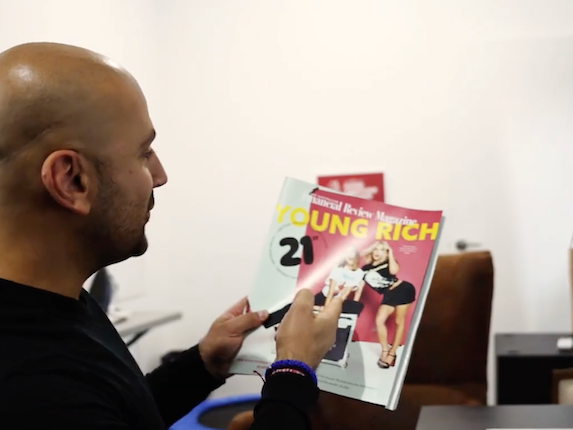While most young people are doing it tough, the richest among them have increased their wealth by 1700%, writes Carl Rhodes.
SINCE 2003, THE Australian Financial Review (AFR) has published its annual Young Rich List. It is a glossy roll call of the top 100 wealthiest Australians under the age of forty.
In 2025, the list reached new heights. The combined wealth of its members soared to $45 billion, a staggering 1700% increase from the $2.5 billion shared by just 62 individuals when the list first appeared.
Topping the list are Canva co-founders Melanie Perkins and Cliff Obrecht, whose personal fortune stands at $18.46 billion. Their success is undeniably impressive.
But behind the headlines of youthful ambition and entrepreneurial triumph lies a more troubling story of deepening inequality, entrenched privilege, and a narrowing path to prosperity for most young Australians.
Leaving young Australians behind
The AFR’s celebration of youthful excess stands in stark contrast to the financial realities faced by most young Australians. While a select few are accumulating extraordinary wealth, that is far from true for the vast majority.
Stagnant wage growth, rising living costs and skyrocketing house prices mean that most young people are doing it tough. Over the past 25 years, the price of the average residential property has jumped from nine to 16.4 times the average household income. Home ownership, once a cornerstone of Australian prosperity, is now a distant dream for many.
Intergenerational inequality is the economic challenge of our time. The economic outlook for the young is worse than it was for their parents and even their grandparents.
This is a matter of mainstream politics, with Treasurer Jim Chalmers asserting earlier this year that:
“The first [objective] is about a fair go for working people and including in inter-generational equity terms.”
Inequality among the young is not equal either. According to the Australian Council of Social Service (ACOSS), as of 2023, the richest 10% of households under 35 had an average wealth of more than $2 million. For the bottom 60%, it was just $80,000.
Even more troubling, the wealth of that top 10% grew at more than seven times the rate of the bottom 60% over the preceding decade. The primary driver? Housing. Those with access to capital bought in early and reaped the rewards. The rest were locked out.
Notwithstanding the considerable achievements of those on the young rich list, they are part and parcel of a system that generously rewards the few while increasingly disenfranchises the majority of young Australians.
A politics of envy?
Concern about economic inequality is often dismissed as a politics of envy. The argument goes that those who have meritoriously risen to the top deserve the spoils of their success, and any criticism of them masks resentful jealousy.
But that “sour grapes” logic only holds if extreme wealth is truly meritorious. So, is all this wealth simply the result of risk-taking, innovation, and the ambitious hard work of those who have the right stuff to pull themselves up by their own bootstraps? The evidence suggests otherwise.
Take gender, for example. Only 17% of the young rich listers were women. That disparity invites two interpretations: either women are inherently worse at making money than men (a claim unsupported by any serious evidence) or the distribution of wealth is not based on merit alone.
Consider venture capital. This year, all-women teams are on track to receive just 0.5% of total venture capital funding, down from 2% last year and 3% the year before. That means for every million dollars invested, only $5,000 goes to female-led startups.
Nevertheless, women-led businesses consistently outperform their male-led counterparts, delivering 35% higher returns on investment. The problem isn’t performance, it’s discrimination.
Privilege also plays a decisive role. One in three Australian startups gets funding from the so-called bank of mum and dad. That is more than those who rely on government support. Family wealth, elite education, and access to networks are powerful accelerants for wealth generation amongst the young.
While many of the young rich are undoubtedly talented and hardworking, those qualities alone don’t explain their success. The playing field is tilted at an ever-increasing angle.
Celebrating fairness
The celebration of the rich by mainstream media outlets like the AFR is all well and good, but do we really need another list celebrating the wealthy? Why not have a new scoreboard, one that measures fairness, opportunity, and shared prosperity?
Wealth creation and economic growth are central to Australia’s future success. But unless we couple that with a concern for how prosperity is distributed, we risk entrenching a society of haves and have-nots, with young working people and women at greatest risk of economic marginalisation.
The Young Rich List showcases innovation and ambition, but it also reflects a system that rewards privilege, entrenches inequality, and sidelines those without access to capital or connections. If we want a fairer future, we must shift our focus from individual accumulation to collective growth and fair distribution.
If we are to celebrate, let’s make it about reducing inequality, investing in inclusive entrepreneurship, and building an economy where success isn’t a jackpot reserved for the lucky few.
Carl Rhodes is Professor of Business and Society at the University of Technology, Sydney. He has written several books on the relationship between liberal democracy and contemporary capitalism. You can follow him on X/Twitter @ProfCarlRhodes.
Support independent journalism Subscribe to IA.
Related Articles





